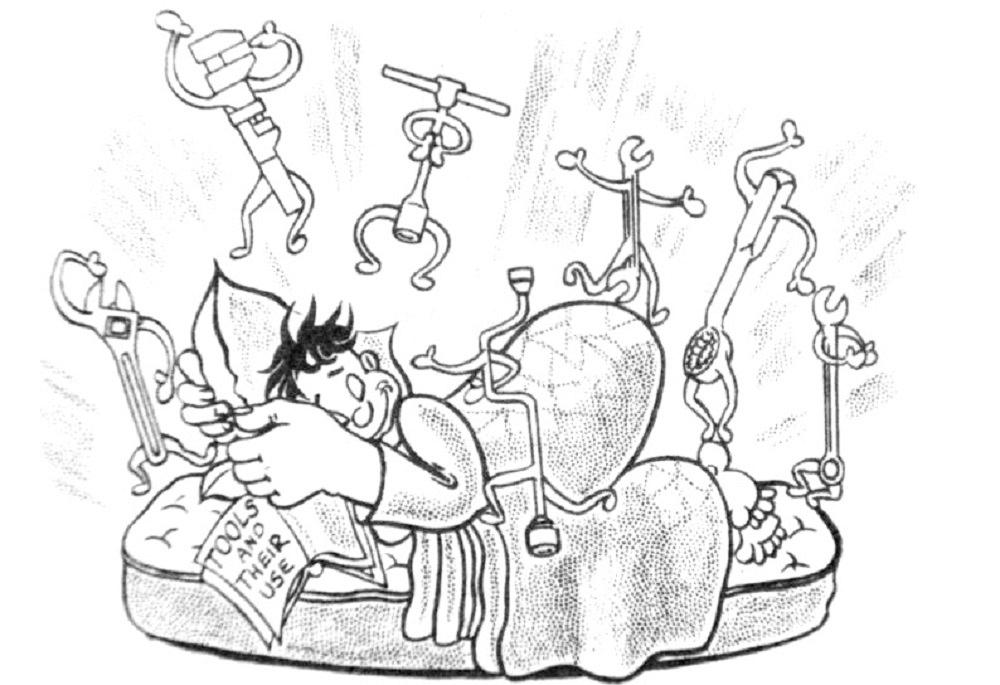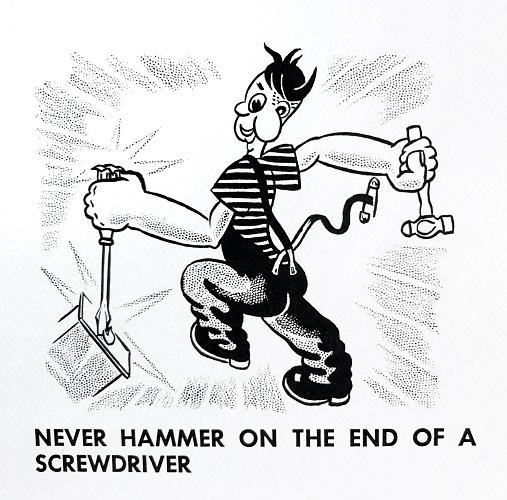Owner, Brown Dog Welding
- FMA
- The Fabricator
- FABTECH
- Canadian Metalworking
Categories
- Additive Manufacturing
- Aluminum Welding
- Arc Welding
- Assembly and Joining
- Automation and Robotics
- Bending and Forming
- Consumables
- Cutting and Weld Prep
- Electric Vehicles
- En Español
- Finishing
- Hydroforming
- Laser Cutting
- Laser Welding
- Machining
- Manufacturing Software
- Materials Handling
- Metals/Materials
- Oxyfuel Cutting
- Plasma Cutting
- Power Tools
- Punching and Other Holemaking
- Roll Forming
- Safety
- Sawing
- Shearing
- Shop Management
- Testing and Measuring
- Tube and Pipe Fabrication
- Tube and Pipe Production
- Waterjet Cutting
Industry Directory
Webcasts
Podcasts
FAB 40
Advertise
Subscribe
Account Login
Search
World War II-era book by U.S. military and GM guides soldiers in how to use hand tools
Collaboration project used illustrations to help train mechanics in the Armed Forces
- By Josh Welton
- June 11, 2019

In 1943 the U.S. Armed Forces and General Motors published a book called Hand Tools: Their Correct Usage and Care for the soldiers.
In downtown Detroit is a branch of the public library called the Skillman Library. In it there is a wing dedicated to the National Automotive History Collection, where you can set up an appointment to scour its archives. You tell the librarian what you’re looking for. He brings you a book that lists all the boxes pertaining to the given subject and a very general summary of their contents. You choose, one at a time, which box you’d like to go through.
Darla and I have been researching the Arsenal of Democracy, and the history of the Dodge car company, the Dodge brothers Horace and John, and their connection with the U.S. military starting from before World War I. I don’t want to be the guy quoting a source that quotes a source like most blogs and online articles seem to do. I want to see the source. Luckily, Detroit is chock full of cool old stuff just waiting to be rediscovered. In the midst of this research we’ve come across some other gems that are too good not to share.
In 1943 the Armed Forces and General Motors published a book called Hand Tools: Their Correct Usage and Care for the soldiers. This quote is how the foreword begins:
“Our ARMED FORCES are in urgent need of more mechanics — many thousands more — to service tanks, planes, guns, armored cars and jeeps.”
Then there’s the introduction to the book, spoken by a fictional man, “The Sergeant.”
“Since you are going to be mechanics, I want you to be GOOD mechanics,” The Sergeant says. That first sentence is in the intro. The second sentence basically says, “Also, we don’t want you to die.” While I’m paraphrasing that line, it is a more accurate description of the awesome cartoon illustrations the book uses to get the point across.
Rather than get bogged down in minutiae, they made cartoons to supplement the very general text. The Armed Forces were bringing in a ginormous number of civilians not used to working with their hands, and the military needed them to get the basics ASAP.
Two years later, GM updated the book for the general population and brought forth a new Flintstones-type character, “Primitive Pete.” It’s pretty much the same as the original, except with a caveman in place of whoever it is in the sketches. I like these sketches better.
subscribe now

The Welder, formerly known as Practical Welding Today, is a showcase of the real people who make the products we use and work with every day. This magazine has served the welding community in North America well for more than 20 years.
start your free subscriptionAbout the Author

About the Publication
- Stay connected from anywhere

Easily access valuable industry resources now with full access to the digital edition of The Fabricator.

Easily access valuable industry resources now with full access to the digital edition of The Welder.

Easily access valuable industry resources now with full access to the digital edition of The Tube and Pipe Journal.
- Podcasting
- Podcast:
- The Fabricator Podcast
- Published:
- 04/16/2024
- Running Time:
- 63:29
In this episode of The Fabricator Podcast, Caleb Chamberlain, co-founder and CEO of OSH Cut, discusses his company’s...
- Trending Articles
Sheffield Forgemasters makes global leap in welding technology

ESAB unveils Texas facility renovation

Engine-driven welding machines include integrated air compressors

How welders can stay safe during grinding

The impact of sine and square waves in aluminum AC welding, Part I

- Industry Events
16th Annual Safety Conference
- April 30 - May 1, 2024
- Elgin,
Pipe and Tube Conference
- May 21 - 22, 2024
- Omaha, NE
World-Class Roll Forming Workshop
- June 5 - 6, 2024
- Louisville, KY
Advanced Laser Application Workshop
- June 25 - 27, 2024
- Novi, MI



























